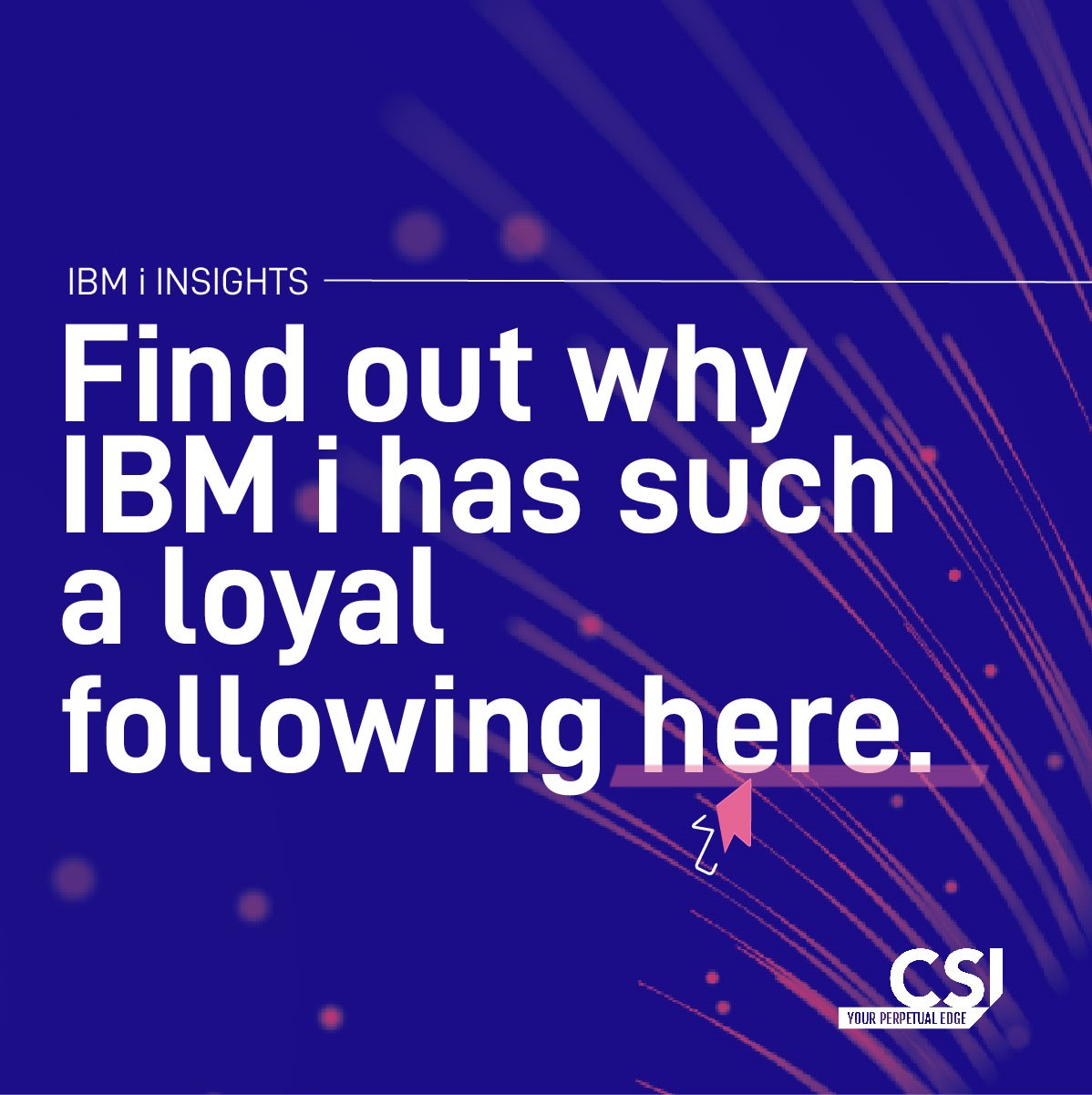A Loyalists Guide to IBM i Modernisation
Time to read: 15
A household name in corporate technology, IBM’s product roadmaps typically follow the same narrative: humble beginnings are complemented by decades of innovation. This sense of reliability and resiliency – where IBM has spent many lifetimes developing an affinity for technology – is perhaps one of the key reasons many of the FTSE 100 companies have at least some branded hardware and software in their deep solution stacks.
With rich solution histories come rewarding futures. That’s how – even after celebrating AIX’s roadmap updates – there’s yet another milestone in everyone’s corporate diary: on 21st June 2023, the IBM i operating system celebrates 35 years in the market.
Don’t just take IBM’s word for it – as a Platinum Business Partner, CSI understands that technologies need to offer businesses transformative, regenerative powers that legacy kit no longer promises. Market leading sustainability initiatives, how we answer regulatory headwinds, and other market pressures, including rising energy costs and evolving threat vectors, are all priorities that often feature high on any IT agenda.
But what’s the name for an operating system capable of delivering modern business transformation? IBM i / AS400/ IBM i series – all capture the same operating system as it has changed across a wide, evolving timeline. In 2023 and beyond, IBM i supports a loyal IBM Power customer base, providing everything from resiliency to flexibility as top reasons to power critical workloads with IBM technologies.
Jump ahead to the insights effecting you right now or read on to learn about IBM i modernisation and your business.
IBM i – Formerly AS/400
Beyond the technology, IBM i is an environment designed to support businesses as they navigate changing demand in today’s busy, regulated marketplaces. Wider afield, in competitive, tech-dense countries like the United States, IBM i is firmly established as a leading operating system for modernisation – this coincides with the density and popularity of a large IBM Power install base. But even seasoned IT journalists, watchful of trends in digital transformation, are still “thankful” for IBM i after all these years.
Unlike competitive market offerings, IBM technologies often have an irreplaceable synergy between products, services, and the wider vision that pins down opportunity for business transformation. Storage options for IBM Power are, for example, efficient and effective in ways that other, agnostic solutions found deeper in the market will lack. This is often because IBM has the deep history, corporate and technical vision, and capability to answer market pain points holistically. That means resiliency, performance, sustainability – or any other salient point high on a business agenda – can be addressed by an area of IBM technologies.
Formerly AS/400, IBM i thirty-five years later still enjoys the same prestige on the global marketplace. It is even revered, in matchups with rivalling market options for standards-based systems, for its TOC (total cost of ownership). IBM’s reputation for storage and servicer innovation rubs off on its wider portfolio, where IBM i series is part of the same vision for meaningful business transformation.
Understanding its naming convention, the operating system is famous for its “integrated simplicity”. IBM explains how:
“With its integrated IBM® Db2® database architecture, IBM i provides a cost efficient, highly resilient and secure foundation for running a wide variety of popular industry applications.”
IBM and CSI speak to a market where competitive differentiation has repositioned digital transformation into a tenet of modern IT. IBM i was built in the image of agile, transformative IT; this means it connects into cooperate desires for technologies to unlock better innovation, cost-efficiencies and more. In fact, the popularity of IBM i over the decades has been in part owed to its role as a reliable platform. It is also admired for its ability to rapidly spin-up solutions without consuming excessive resources.
IBM i follows three key focus areas:
- Prioritise solutions
- Open source
- Integrated value
With modernisation, scalability and transformation in mind, IBM i enables businesses to look ahead. Specifically, the platform is open to new technologies, offering flexible integration that works around clients’ needs. IBM comes with a deep technical base – and partnerships like CSI – which means solutions can be spun up quickly without skills shortages disrupting your ability to innovate. Lastly, ongoing integration is a theme within wider suite of IBM i products, so gaps do not form in technology stacks.

Is AS/400 “Dead”?
AS/400 is a name for the ancestor of the IBM i environment. But the naming convention AS/400 or iSeries are both often still used playfully within the wider community.
IBM i products are still available and popular on the global market and underpin many of today’s top organisations.
Why Are We Celebrating the IBM i Anniversary?
Whilst there are competitive alternatives to IBM i, the guarded defence and celebration for the operating system testifies to its longstanding market reception as a kind of engine for modernisation. Many clients, in conversation with CSI, often relish the unmatched reliability, uptime and resilience.
But how far does that loyalty go?
The IBM i install base maps an impressive territory of global enterprises where loyalty runs as deep as IBM’s technical roots. In fact, IBM expertise and the technical etiquette of its behind-the-scenes operators are often praised. With many capabilities under one roof, IBM technologists can play different roles, whether your business needs an analyst, a security watchdog, or a way to simplify and address regulation.
Behind IBM i is a deep network of user groups, who, undeterred from the global pandemic, still champion skills and expertise for the global platform. This means that not only is there continuity behind IBM i, but there’s a wider community too. And one where skills and insights are shared into relevant businesses.
Here’s Why Customers Are Loyal to IBM i
Originally released in 1988 as AS/400, renamed in 2005 to i5/OS, and finally rebranded as IBM i in 2008, the longevity of the platform testifies to its widespread use in enterprises where a reliable and powerful operating system is critical to workloads.
IBM i includes key features such as:
- High availability: IBM i is designed to be highly available, with a 99.99% availability SLA. This means that businesses can be confident that their applications will be up and running when they need them.
- Security: IBM i is, importantly, a secure operating system, offering several features that protects data and applications from unauthorized access. Some of these features include role-based access control, encryption, and auditing.
- Integration: IBM i is designed to be easily communicate other systems, technologies, and applications.
- Cost-effectiveness: IBM i is a cost-effective operating system, which is often praised for its total cost of ownership.
Why IBM i for Businesses
Aside from its key features, IBM i has become a reliable platform for businesses because it speaks to key corporate goals and desires.
“It is not just an ideal platform for growth, but it speaks to modern markets where businesses must remail agile and adapt to demand.”
Security, competitive irrelevance, regulatory pressures are all areas of disruption that can cause a business to quickly lose profitability in its key markets. IBM i addresses common anxieties by enabling the kinds of meaningful changes that keep businesses competitively differentiated in their space.
IBM i can help businesses achieve different goals, such as:
- Modernisation: As a modern operating system, IBM i has a history of reinvention. This means, through a timeline of different brand names and versions, IBM i has emerged with a new set of capabilities and products built for any enterprise.
- Scalability: IBM i is a scalable operating system that can be easily scaled up or down to meet the needs of businesses of all sizes. It is not just an ideal platform for growth, but it speaks to modern markets where businesses must remail agile and adapt to demand.
- Reliability: IBM i is legendary for uptime, which gives it the namesake for being a reliable platform of choice. In uncertain times, IBM i has the hearty longevity and style of a favourite car. It just keeps on going.
Ask An Expert
Whether you’re interested to learn more about the IBM i platform, or you want to unlock the most from your IBM investments, get in touch today.
About the author
Ready to talk?
Get in touch today to discuss your IT challenges and goals. No matter what’s happening in your IT environment right now, discover how our experts can help your business discover its competitive edge.
